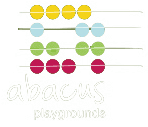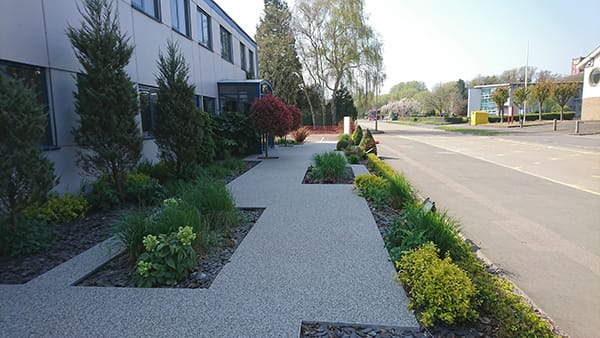Choosing the right surface for a school, park, visitor attraction, or public walkway isn’t just a question of budget—it’s about long-term value, safety, aesthetic appeal and compliance. Whether you’re a school estates manager, a local authority procurement officer, or a contractor working with architects on a large public space, your choice between resin bound gravel and traditional paving could have long-lasting implications for your site.
Resin bound gravel is often the better choice for projects needing permeability, low maintenance, and a modern, seamless finish. Traditional paving may suit heavy-use or budget-restricted areas. The right option depends on your site’s drainage needs, usage, and long-term goals.
In this guide, we compare resin bound gravel surfacing with traditional paving methods like tarmac, concrete, and block paving to help you decide which option is best suited to your next project.
What Is Resin Bound Gravel Surfacing?
Resin bound gravel is a permeable surfacing solution made from natural stone aggregates mixed with a clear UV-stable resin. Once laid, the mix forms a smooth, durable finish that allows water to drain through, making it compliant with Sustainable Drainage Systems (SuDS) regulations.
This modern surface is often seen in:
- School pathways and courtyards
- Pedestrian routes in public park
- Decorative zones around visitor attractions
- Golf course footpaths and buggy tracks
What Do We Mean by Traditional Paving?
Traditional paving refers to long-established methods of ground surfacing, including:
- Tarmac (asphalt): Widely used in roads and school car parks.
- Concrete slabs: Durable, load-bearing solutions for commercial zones.
- Block paving: A modular approach, often used for paths and driveways.
These materials are known for their strength and ease of installation but often fall short in areas like permeability and aesthetics.
Side-by-Side Comparison: Resin Bound vs Traditional Paving
Let’s compare the two options across the criteria that matter most for schools, councils, and construction teams.
1. Appearance and Design Flexibility
Resin Bound Gravel:
- Offers a seamless finish with a wide range of aggregate colours
- Customisable patterns and logos (ideal for branding in schools or attractions)
- Naturally blends into landscaping
Traditional Paving:
- More limited in visual appeal unless high-end blocks or stone are used
- Can look dated or industrial in educational or recreational settings
Winner: Resin Bound, particularly for creative outdoor environments or heritage sites.
2. Durability and Longevity
Resin Bound Gravel:
- Designed to withstand heavy pedestrian use
- Long-lasting with minimal cracking if installed correctly
- Resistant to freeze-thaw cycles
Traditional Paving:
- Tarmac is strong but prone to cracking and potholes
- Concrete is robust but can be slippery and stain easily
- Block paving is durable but may shift or sink over time
Winner: Draw, with both offering good durability in the right setting.
3. Drainage and Permeability
Resin Bound Gravel:
- Fully permeable—water drains through the surface, reducing puddling
- SuDS-compliant and excellent for flood-prone areas
- Helps schools and councils meet planning permissions without additional drainage systems
Traditional Paving:
- Typically impermeable unless additional soakaways or gullies are installed
- Block paving offers some permeability but requires careful base preparation
Winner: Resin Bound, especially where surface water management is a priority.
4. Installation and Lead Times
Resin Bound Gravel:
- Can be laid directly over existing tarmac or concrete bases
- Typically ready for use within 24–48 hours
- Minimal disruption to school grounds or public areas
Traditional Paving:
- Longer installation periods, especially for concrete curing or block laying
- Tarmac can be laid quickly but often requires resurfacing or planning permission
Winner: Resin Bound, for fast turnarounds and minimal downtime.
5. Slip Resistance and Accessibility
Resin Bound Gravel:
- Smooth, anti-slip finish—ideal for children, prams, wheelchairs and those with mobility issues
- Can be customised for extra grip
Traditional Paving:
- Tarmac is generally safe, but can become slick when wet
- Concrete and block paving may develop trip hazards as they age
Winner: Resin Bound, particularly for compliance with DDA (Disability Discrimination Act) standards.
6. Maintenance and Upkeep
Resin Bound Gravel:
- Low maintenance—no loose stones, weed growth or shifting
- Easy to clean with occasional power washing
- UV-stable resin prevents discolouration
Traditional Paving:
- Tarmac may need patching and re-sealing over time
- Block paving is prone to weed growth and sinking
- Concrete can crack and stain
Winner: Resin Bound, with long-term savings in maintenance contracts.
7. Cost Effectiveness
Resin Bound Gravel:
- Higher initial cost but lower lifecycle costs due to low maintenance and longevity
- Reduces the need for expensive drainage systems
Traditional Paving:
- Lower upfront cost (especially for tarmac)
- May incur higher repair, replacement and compliance costs over time
Winner: It depends—resin bound is cost-effective over the long term, while traditional paving may suit tight upfront budgets.
When to Choose Resin Bound Gravel
Resin bound gravel is the superior option for:
- Schools needing colourful, engaging and safe play areas
- Local authorities working on park paths and public walkways with drainage concerns
- Architects designing modern, natural-looking landscapes
- Golf courses seeking low-maintenance pathways with visual appeal
- Contractors delivering premium public realm projects on tight schedules
It also aligns well with sustainability goals, especially when paired with recycled aggregates.
When Traditional Paving Makes Sense
Despite its limitations, traditional paving may be more suitable for:
- Heavy vehicle areas such as maintenance yards or drop-off zones
- Short-term or budget-restricted projects where upfront cost is critical
- Industrial or commercial developments requiring extra load-bearing capacity
Block paving, in particular, offers easy spot repairs and a modular approach—beneficial in high-traffic or utility-heavy areas.
Additional Factors to Consider Before Choosing
When deciding between resin bound gravel and traditional paving, consider the following:
- Usage type: Will the area see foot traffic, bikes, or heavy vehicles?
- Drainage requirements: Is the site in a flood-risk zone?
- Planning regulations: Do SuDS or DDA requirements apply?
- Project scale: Is a phased installation or minimal disruption essential?
- Long-term goals: Are you planning a low-maintenance future?
Ultimately, choosing the right surface isn’t just about product—it’s about finding the best fit for your users, environment and vision.
Partner with Abacus Playgrounds for Trusted Surfacing Solutions
With decades of experience in educational surfacing, public play spaces, and contractor partnerships, Abacus Playgrounds provides tailored surfacing advice and solutions across the UK.
We support schools, local authorities, and commercial contractors with:
- Full specification packs for resin bound and traditional surfacing
- Experienced project management from consultation to completion
- Compliance-ready materials for SuDS, DDA and safety standards
If you’re unsure whether resin bound gravel or traditional paving is right for your site, our expert team is here to help.
Get in touch today for a no-obligation quote or to speak with one of our surfacing consultants. Together, we’ll build a surface that lasts.

